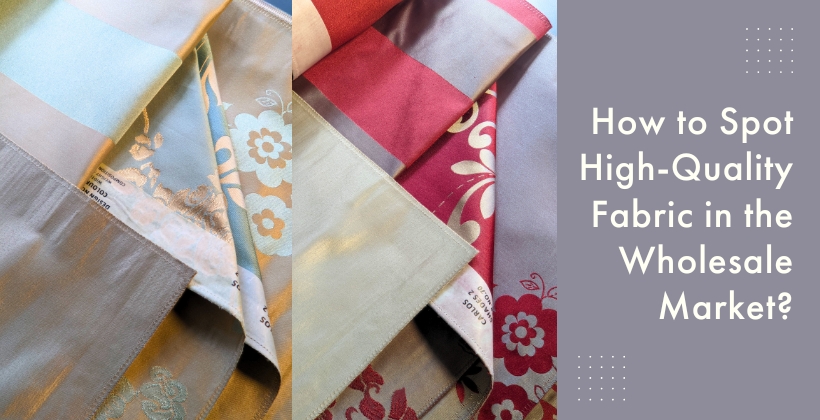How to Spot High-Quality Fabric in the Wholesale Market?

The wholesale fabric market can be overwhelming with its wide variety of materials, colors, and designs. Whether you’re sourcing materials for a business or personal project, knowing how to identify high-quality fabric is crucial to making informed purchasing decisions. If you’re specifically looking for upholstery fabric for curtains, it’s essential to understand the key factors that contribute to durability, aesthetics, and value for money.
- Understand the Purpose of the Fabric
Before diving into the technical details, it’s important to identify the specific requirements for your project. Upholstery fabric for curtains, for instance, should balance durability with elegance. Curtains serve both functional and decorative purposes, so the fabric you choose must enhance your interiors while withstanding wear and tear.For heavy-duty use, fabrics such as polyester blends, jacquard, or velvet are ideal as they provide resilience and a touch of luxury. On the other hand, if you’re aiming for lightweight and airy curtains, cotton or linen might be the best option.
- Inspect the Fabric’s Weave and Texture
One of the first steps in assessing fabric quality is examining its weave. High-quality upholstery fabric for curtains often has a tight and consistent weave. A well-woven fabric will feel smooth and sturdy, without visible gaps or irregularities.For upholstery purposes, test the fabric’s texture by running your fingers over the surface. It should feel even and free of snags or pulls. Coarser textures might indicate poor manufacturing, which could lead to premature wear or unraveling.
- Assess the Durability
Durability is a key factor for upholstery fabrics, especially when used for curtains that face regular handling or exposure to sunlight. Check the fabric’s weight and thread count. Heavy fabrics tend to be more durable and better suited for long-term use.For added durability, look for fabrics that are fade-resistant and have protective coatings. Many high-quality upholstery fabrics are treated to resist stains and moisture, which enhances their longevity in home or commercial settings.
- Evaluate the Color and Finish
High-quality fabric maintains its color and finish even after prolonged use. When shopping for wholesale fabrics, ensure that the colors are vibrant and evenly distributed. Uneven dyeing or faded spots can be a sign of inferior quality.For upholstery fabric for curtains, consider how the finish affects its appearance and functionality. Matte finishes are often preferred for a subtle and sophisticated look, while glossy finishes can add a touch of luxury to your interiors. Always ask if the fabric has been pre-treated to resist fading caused by sunlight exposure.
- Test for Stretch and Recovery
Stretch and recovery tests help you determine the elasticity and resilience of a fabric. Pull a section of the fabric gently to see if it stretches and how well it returns to its original shape. High-quality fabrics typically have minimal stretch and recover their shape quickly, ensuring they retain their appearance over time.This test is particularly important for curtain fabrics as they’re often hung in pleats or folds. Poor-quality fabrics may lose their structure and sag, which can ruin the aesthetic of your curtains. - Verify the Fabric’s Composition
Understanding the material composition is vital when selecting upholstery fabric for curtains. Natural fibers like cotton and linen offer breathability and a classic look, while synthetic fibers such as polyester provide durability and stain resistance. Blended fabrics combine the best of both worlds, offering a balance of comfort and performance.If possible, request a sample and inspect the fabric’s label or description for details about its composition. This information can help you make an informed choice based on your specific needs.
- Look for Certifications and Standards
Reputable fabric wholesalers often provide certifications or adhere to quality standards that ensure their materials meet specific benchmarks. For instance, Oeko-Tex certification guarantees that the fabric is free from harmful chemicals, making it a safer choice for homes and workplaces.For upholstery fabric, look for standards that address colorfastness, abrasion resistance, and environmental impact. These certifications can serve as a benchmark for quality and reliability.
- Compare Prices with Quality
While price isn’t the sole indicator of quality, extremely low prices may signal compromised materials. High-quality upholstery fabric for curtains may cost more upfront but will save you money in the long run by offering better performance and durability. Always balance your budget with the fabric’s quality to ensure you get the best value. - Consult with the Wholesaler
Building a relationship with your wholesaler can provide valuable insights into fabric quality. Reputable wholesalers are transparent about their sourcing and manufacturing processes and can guide you to the best options for your needs. Don’t hesitate to ask questions or request detailed product information before making a purchase.
Conclusion
Spotting high-quality fabric in the wholesale market requires a combination of technical knowledge and careful observation. By focusing on factors such as weave, durability, colorfastness, and material composition, you can ensure that you select the best upholstery fabric for curtainsthat meets both your functional and aesthetic needs.
Always work with trusted wholesalers who prioritize quality and offer a wide range of options to suit your preferences.
Investing in premium fabrics not only elevates your space but also ensures long-lasting value. So, the next time you step into the wholesale market, keep these tips in mind to make confident and informed decisions.
Newsletter
Subscribe our Newsletter for new blog posts, tips & new photos. Let’s stay updated!
